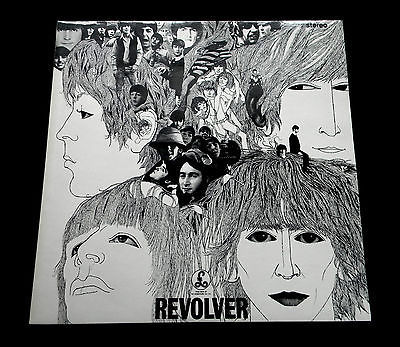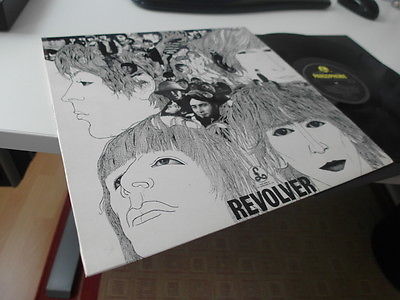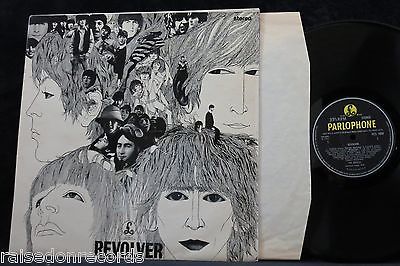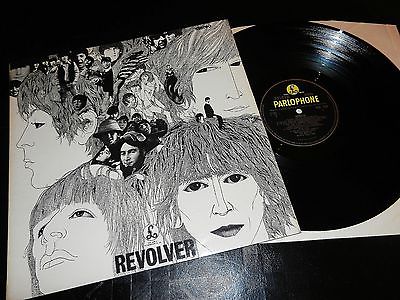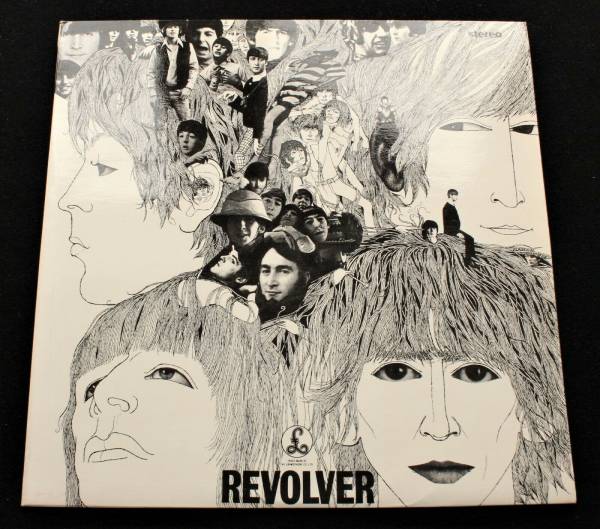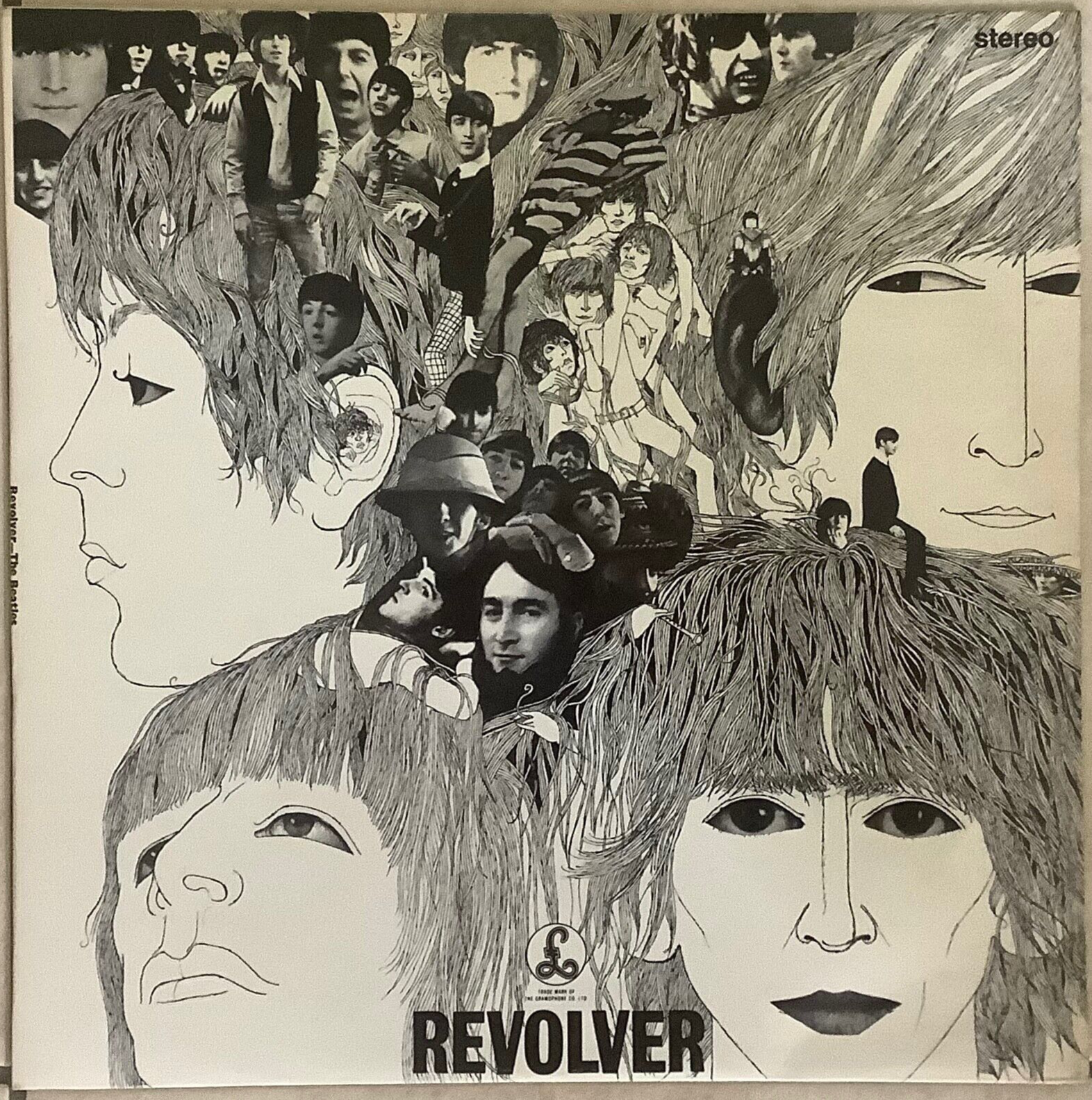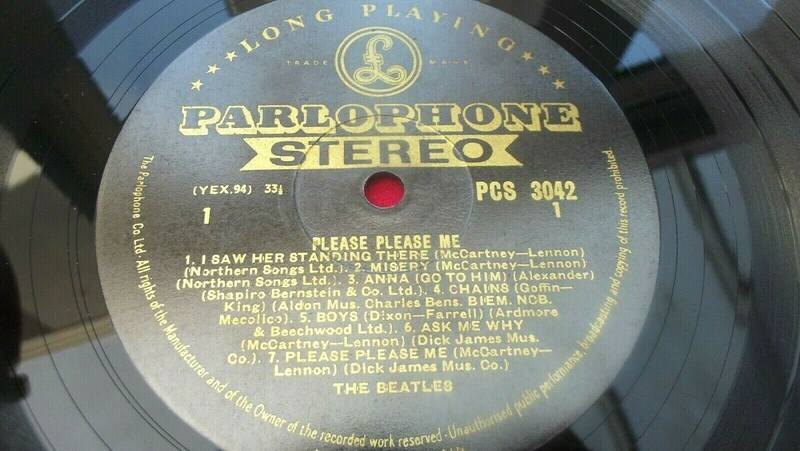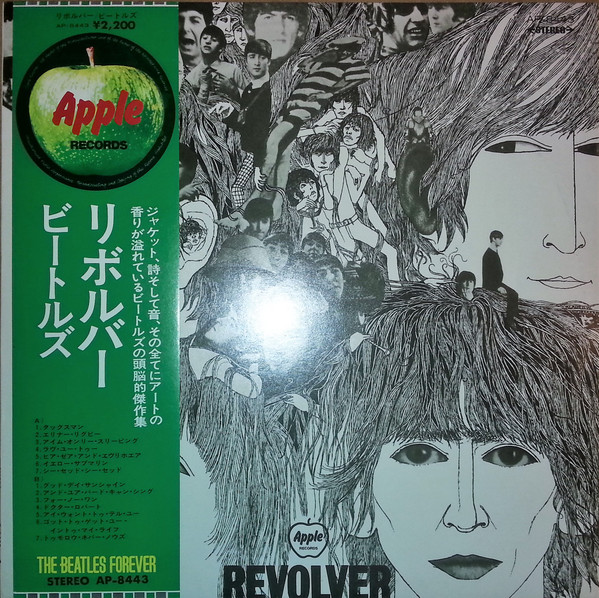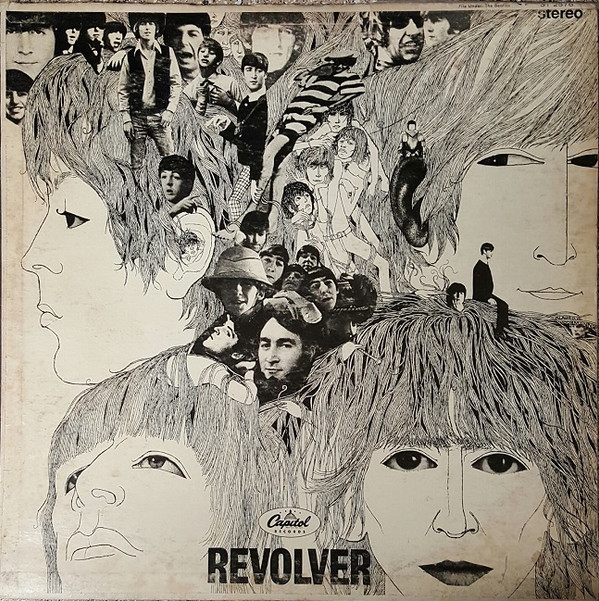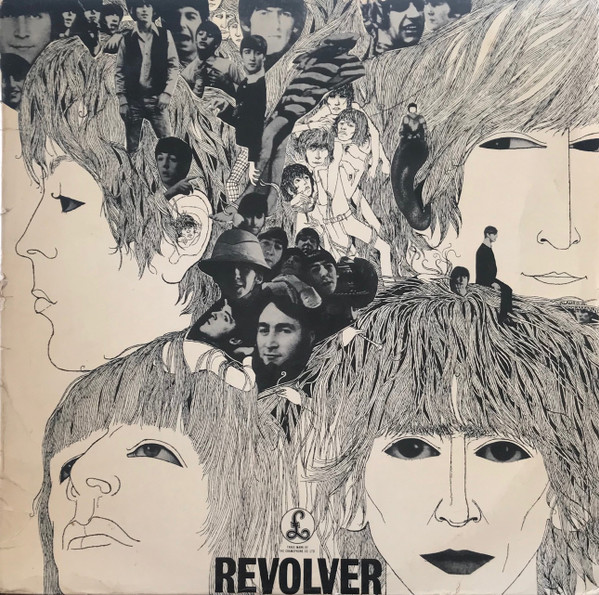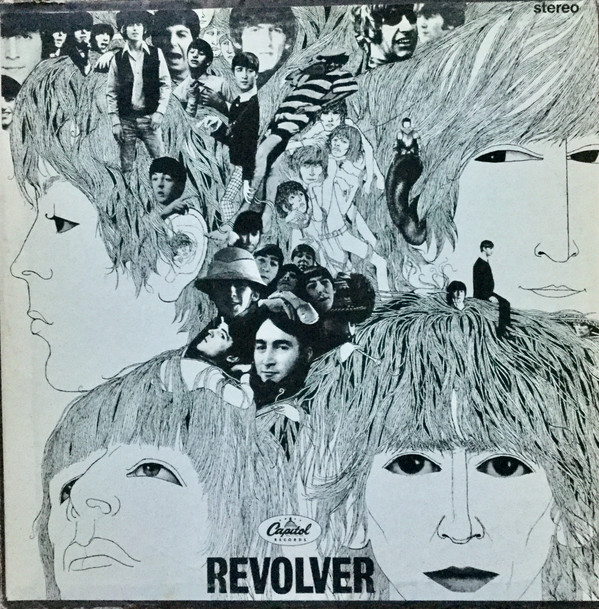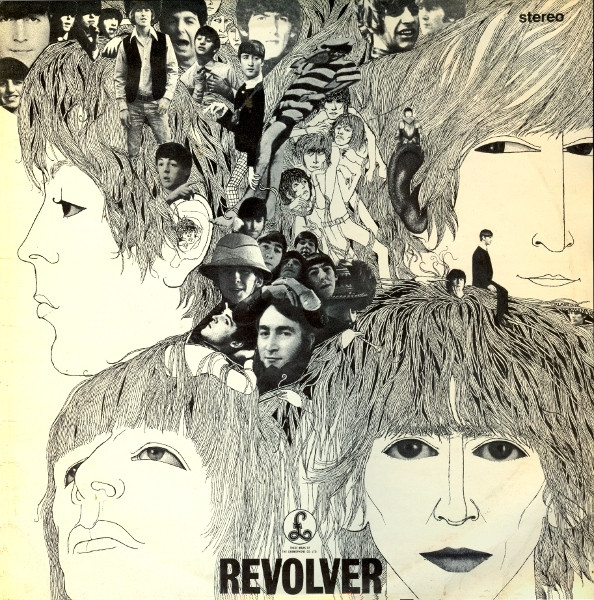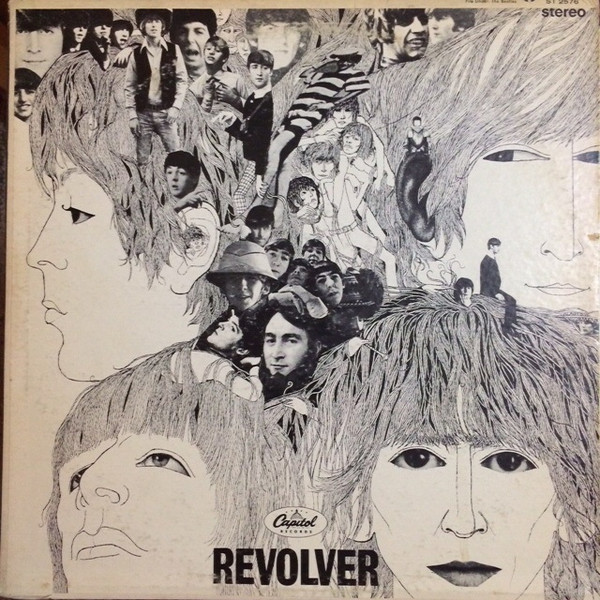Item Description
Turn off your mind, relax and float down stream,
It is not dying , it is not dying.
Lay down all thought, surrender to the void,
It is shining, it is shining.
That you may see the meaning of within,
It is being, it is being.
That love is all and love is everyone,
It is knowing, it is knowing.
That ignorance and hate may mourn the dead,
It is believing, it is believing.
But listen to the colour of your dreams,
It is not living, it is not living.
Or play the game, existence to the end.
Of the beginning, of the beginning,
Of the beginning, of the beginning,
Of the beginning....
BEATLES: Revolver LP. AUTHENTIC VERY FIRST UK PRESSING IN RARE STEREO, ISSUED 13th AUGUST,1966.
How exciting to have a superb first UK pressing of Revolver, in the sensory, first made true Stereo mix, to play and describe .
1966 was very much a predominantly Mono stronghold, no different to the 1963 Please Please Me Stereo albums, EMI only pressed
in very small batches, obviously preparing the Stereo and Mono mothers right at the beginning of manufacturing. As this genuine very
first Stereo record s pair of mother digits indicate, very low Stereo mothers were required and made until the end of the year,
Side 1 from the second mother and Side 2 from the first mother. This week I was once explaining how mistaken double digits at
9 o clock in the run-out grooves meant, for a first pressing of the 1963 I Want To Hold Your Hand single with zero s after the
first digits on both sides. No record ever exceeded single mothers, not even the huge selling Beatles singles ever reached double
mothers. A mistake regularly found in the 1960 s 1970 s decades, I always state I only take the first digit stamped as the
as the one intended, or the first digit was crossed out or over stamped. Well, this Revolver has that exact scenario, on Side 1
a 2 digit was mistakenly stamped due to the other side actually requiring that setting on the stamping machine, the error was
seen and the 2 was indeed over stamped with an X or maybe Z . Then underneath the intended 1 was stamped very clearly, it
seemed a good opportunity to show that, so out of interest I included a close-up picture of the crossed out 2 the 1 digit
signifying the first mother. These genuine very first pressings in Stereo would have been prepared and pressing July, 1966 for
the August release, does that matter? Yes, very much so, because the Stereo Revolver pressings were made in such small numbers
they were made with similar Parlophone label and text right up to mid-1969. It is easy to identify the genuine July, 1966 very
first pressings from late 1966, 1967, 1968 1969, I will give full very first pressing details below, first I will deal with second
pressings as I have started to discuss them and they were available in late 1966 and early 1967.
The following late November - December,1966 early 1967 Revolver stereo pressings, are easily identified, in that period all
Parlophone records had the label s Stereo silver lettering in the largest size ever seen in the 60 s. For example, the Beatles
album released then was A Collection Of Beatles Oldies , all Stereo first pressing had the large lettering and a different font in,
Times Roman. Including the Mono records, Mono was not printed on the labels because the vast majority were expected to be and
indeed were Mono. That applied to any back catalogue Stereo pressings, the Beatles album positively being re-pressed then, was
Rubber Soul , the copies with large Stereo lettering are often misquoted as 1965 first pressings.
YELLOW BLACK PARLOPHONE LABEL: PCS 7009.
MAITRIX: YEX 605 - 1 / YEX 606 - 1
The -1 /- 1 end digits were the starting point for the pre-release stereo records, the first mono records are the best known
of all the Beatles albums, the Stereo records did not initially have an alternative mix of Tomorrow Never Knows.
EMI STAMPING CODES: RO 2 / RO 1
With the described error, crossing out and correction which is available to view in my pictures, there will be other first Stereo
pressings with the same error because of the nature of vinyl manufacturing.
THE DISTINCTIVELY TEXTURED VERY FIRST PRESSING YELLOW BLACK LABELS HAVE:
1. STEREO IN BLOCK SILVER SMALL/ STANDARD LETTERING
Unlike the second pressing in late 1966, first pressings were in Sans Serif Arial font
2. THE Sold In UK TEXT
3. Gramophone Co. Ltd. ON THE RIMS.
4. THE UK TAX CODE, KT IS EMBOSSED ON SIDE 2, EITHER SIDE OF THE SPINDLE HOLE.
NOW THE LABEL TEXT EXCLUSIVE TO THE AUGUST,1966 VERY FIRST PRESSINGS:
5. SIDE 2 HAS THE FIRST, I STRESS FIRST, MISTAKEN TITLE Doctor Robert MISPRINTED AS Dr. Robert
I regret revealing that when I joined ebay, it is so misunderstood and completely mixed up with all re-issues now, it has become
meaningless. Just like the ridiculous misunderstood omition of Her Majesty in 1969, now, amateur record sellers believe that
song title was supposed to be printed on the Abbey Road cover. Bar coded and Picture Disc copies are being sold as rare due
to not having Her Majesty printed on the covers.... it never was in any decade
The one and only relevance of Doctor Robert is on the very first pressings in Mono and Stereo, both are extremely rare due to
the UK Stereo format in 1966 and because the very first Mono pressings having an alternate mix of Tomorrow Never Knows.
As the same error over the incorrect spelling of Dr. Robert was never corrected on the back cover, so printers continued to
repeat the same mistake on the labels in every decade... just like the Abbey Road cover. Nothing I say now will stop such
ignorance and why I regret placing this and many other specific mistakes, exclusively connected to the very first pressings.
6. BOTH SIDE LABELS PRESENT THE TRACK LISTING ON ON INDIVIDUAL LINES.
Later pressings overlapped the longer titles onto the next lines, please refer to my label pictures for this and the next and
final label text item.
7. THE SONG TITLES ARE IMMEDIATELY FOLLOWED BY THE COMPOSING CREDIT, THEN THE LEAD VOCALIST.
For example
Tax Man Harrison - George Harrison
All later pressings reversed the composer s and lead vocalist after the track titles.
Tax Man George Harrison - Harrison
Once again, very similar to UK Abbey Road cover, on the back of the Revolver cover, track listing has the same format of
the composer s followed by the lead vocalist as these very first pressing labels. When the labels were changed on the re-issues
the cover remained unchanged like the misspelling of Dr. Robert , hence the Abbey Road comparison. Neither cover was ever
amended, I know I will be ignored again, but I do not write descriptions for record sellers, this is info is for collector s.
Individual printing details pertinent to authentic first pressings do not exist in isolation, it is always the combination of
several items collectively, therefore the first pressing of Revolver in both Mono and Stereo cannot be mistaken....but as I
write, several record sellers on ebay etc. will be misrepresenting blatant and obvious reissues in ignorance and deliberately.
ORIGINAL AUGUST, 1966, EMI INNER SLEEVE IN HARDLY USED, UNAGED MINT- CONDITION.
Just a light record impression, a perfectly stored cover like this, without any stains or discolouration, has every chance of an
unaged inner sleeve. Especially being without the glue absorption discolouration poly- lined inner s usually suffered from.
By 1966, all the remaining earlirer 60 s Use Emitex tracing paper lined inner sleeves had been used up and plain white, curved
edges inner s were introduced, the only printing on the front rim is Made In Great Britain and the Patent Number.
FIRST ISSUE 1966 Garrod Lofthouse , STEREO FLIPBACK EDGE COVER, WITH THE TEXT, Patents Pending,
PRINTED ON THE BACK S BOTTOM FLIPBACK EDGE. IT WILL BE INTERESTING TO EXAMINE THESE FIRST STEREO
COVERS BECAUSE BETWEEN 1965 AND AUGUST 1966, GREAT DIFFERENCES WERE MADE TO THE BACK PANEL.
In August, 1965, the first Stereo pressings of Help had Stereo record record playing information set inside a box, as favoured
by EMI in the first half of the 1960 s, in December,1965 by mistake or deliberation, Rubber Soul had that information omitted.
Next in line in August, 66, Revolver broke with all the traditions and had the Stereo records info printed outside a box and on
individual long lines above the bottom flipback edge, in such tiny text it s extremely difficult to read, perhaps why nobody has
noticed it s presence and commented about the uniqueness, in terms of a 1966 first pressing s features. Why people selling
re-issues have to involve such unique additions when first introduced on first pressings, is a mystery to me, what happened in
later decades had no bearing at all on what preceded them, or you might as well claim rarities differences by virtue of having
something like a bar code The word Doctor/ Dr. comes to mind here but not now Then only months later in December,1966 EMI
re-instated the boxed Stereo info format on the back of Stereo A Collection Of Oldies first pressings, last seen in August, 1965,
like this Revolver format, that always began with
IMPORTANT. This record is intended for use only on special Stereophonic reproducers. If you are doubtful......etc. etc.
In June,1967, with Sgt.Pepper s lavish artwork, the complete lack of any Stereo record details was most likely connected with
the nature of the cover itself, the Stereo box was far from redundant, well almost The White Album had the same scenario as
Sgt.Pepper s gatefold cover, artwork taking priority over technical warning s . January,1969 it returned, but with the sides
of the box missing on the Stereo Yellow Submarine LP s, leaving off the top and the bottom line, by now it was edging towards
mono being deemed doomed to continue into the 1970 s decade, EMI introduced a Mono info record playing text for the first time on
the mono Yellow Submarine cover, once again set inside the same side-less box. For the time period between the 1965 Help
and the 1966 Collection Of Oldies , making the open long line format fond on Stereo first pressings of Revolver unique to this
cover alone during the whole of the 1960 s decade. There is no point looking for a logical reason because it was just the way it
happened, by late 1969 - early 1970, neither Stereo or Mono were printed on the front top right corners.
THE COVER WAS BARELY USED, EVEN IN 1966, THE LAMINATED FRONT IS EXTREMELY CLOSE TO BEING THE ORIGINAL
OFF- WHITE OF THE MONO STEREO FIRST EDITION COVERS.
I cannot not name a Revolver first issue cover having a pure white background, because it never was pure white, more off white
like the first issue 1968 White Album gatefold covers. Virtually every 1960 s Revolver covers developed over large laminate
edge lines on the front left edge meeting the spine. With average handling, they cracked open and nasty yellow/brown stains bled
into the cover like veins, often from the edges as well. This is one of the few I have ever seen without a solitary edge line, a
very rare cover without the ugly stained stripes that ruin the wonderful black and white artwork, regardless of Mono or Stereo,
the same applies. I must include that when grading the cover because of how lovingly handled and stored this was, while being
aware 1966 is not 50 years ago Like the record, this cover was only used four/five times, so all I have to describe comes under
holding a heavyweight record only, allowing for the merest rubbing to the matt back in a very small section. Middle, far left
behind John Lennon s head in the studio photo, directly where the record was resting for 50 years, I did say small and it is faint.
Even the pointed spine s extreme tips are unworn, so are the pair of right side corners, just the slightest standing pressure to
the bottom pair, too minor to mention. Other to that, there is not an item wear related from use, a really beautiful looking rare
first edition, Stereo cover. The front top right corner has Stereo is in the standard small size lettering that followed 1964 s
reduction from middle size lettering when compared to the 1963 largest Mono and Stereo black lettering, a close up picture is
among the photo s. The most common Beatles Stereo UK covers in general are from the late 1969 - early 1970 period, by then
Stereo had became an accepted format, they also came in flipback covers, but those do not have Stereo printed on the front top
corner, there was no need to when Mono was made redundant. The front ultra thick lamination still has the original 1966, mirror
like glossy shine over the white background to Klaus Voorman s superb artwork, that is really bright, without the discolouration
that affected nearly all mono and stereo original covers. The mega heavyweight record s shape has left only a reasonably mild
impression, so there are none of the large laminate wrinkles and creases common to the cover, just the usual few laminate lines
that naturally form over all of those decades. They are edge lines only and a natural occurrence, therefore completely unrelated
to wear but as I said this is not suffering from severe staining, common to all light colour laminated covers, but Revolver was
the album cover to suffer the most and I have a theory for that. EMI introduced plain white inner s, so the heavyweight records
no longer had a thick lining acting as a further barrier against the panels,the sides and of course against the spine. Previously
a double fold on the vertical sides of the previously lined type, referred to as the Use Emitex inner s. I am not looking for
excuses for the excessive staining on most or the normally excessive rubbing on the black matt back panel, genuine 1966 stereo
covers are rare enough not to require that, I deal with facts and include such natural events in my grading. I will stress the
spine titles are perfectly clear and to prove how lovingly stored this has been, both of the spine s pointed endings or the left side
corners are unworn, that alone is a major rarity
This is a really beautiful looking cover and I strongly recommend seeing it for yourself in my pictures, taken in natural sunlight,
not the false white a camera flash creates. The front has unfaded, jet black ink on the artwork, including in that jet black colour,
the Stereo block lettering, against the white colour, a superb contrast.
The flipback edges are all perfectly and neatly stuck down, in very sound, strong condition, with only a few tiny laminate lines
that once again naturally form from the standing pressure and holding a record, which was the purpose of the cover and it has
protected the precious vinyl inside.
Taken as a whole entity, a rare and really beautiful cover with all described here attributable to forming naturally over the long
lifetime, I feel guilty downgrading it because the one previous owner could not have done any more, my grading should not involve
Excellent but I will still use common sense here.
THE COVER IS IN A MINIMUM OF EXCELLENT / NEAR MINT CONDITION, MY EMPHASIS FALLS ON NEAR MINT.
ONLY PLAYED FOUR / FIVE TIMES TIMES, AS SEEN ON THE IMMACULATE LABELS, EVEN THE EMBOSSED KT LETTERS
ARE UNWORN AND HAVE THE THIN BLACK PAPER AS NEW. THE GLOSSY VINYL IS NOT SCRATCHED, ANY HANDLING
IS FEATHER LIGHT AND NEAR INVISIBLE. THE TRUE STEREO SOUND IS JUST STUNNING, WITHOUT ONE CRACKLE OR
SURFACE SOUND ON THE ENTIRE RECORD, INCLUDING EVERY TRACK GAP, ABSOLUTELY PERFECT SOUND ON EVERY
SECOND IS VERY RARE FOR A 1966 FIRST PRESSING OF Revolver.
MY GRADING HAS TO BE NEAR MINT CONDITION.
SIDE 1
Taxman George Harrison
Eleanor Rigby
I m Only Sleeping
Love You To George Harrison
Here, There And Everywhere
Yellow Submarine
She Said She Said
SIDE 2
Good Day Sunshine
And Your Bird Can Sing
For No One
Doctor Robert
I Want To Tell You George Harrison
Got To Get You Into My Life
Tomorrow Never Knows
All Songs written By John Lennon Paul McCartney, Except Where Credited To George Harrison.
Recorded 6th April / 21st June 1966, At Abbey Road Studios.
The recording sessions for the Beatles album regarded by most as one of, if not the the greatest album of all time, began on the
6th April, 1966. The first track recorded in Abbey Road studio for Revolver, an album that would forever change the concept
of popular music, had an unassuming title of Mark One . This was a recording of such immensity, that a simple x would have
sufficed until some kind of retrospective examination of what exactly had quite been laid down during one of the most inspired
opening to a recording session in all of rock s long and illustrious history periods. At least Sgt. Pepper / Strawberry Fields
had something this extraordinary to follow, but prior to April 1966, nothing had gone this far and deep into pure psychedelia.
Mark One could have been a statement of intent, that was the song title given to mark the tape spool box, or as that is known
a working title given until an actual finalised song title has been arrived at. That historic day spent in Studio 2, the Beatles
recorded three takes that would form the basic track of what would become the most mind blowing recording ever heard in
or before 1966, or come to that, still until this very day. The genius of John Lennon stepped into the void and returned with
something that would alter the way recording studios had previously been used, the visionary sounds in Lennon s mind would
be translated into astonishing sounds by George Martin and EMI s sound engineers. Tomorrow Never Knows was where the
Beatles music was always heading towards, because Revolver was not just an isolated album that happened by pure chance,
their music evolved while the Beatles made a staggering progression through the Golden 1960 s with a positive belief nothing
was impossible.....unless you believed it was Of course that era s experimentation s with mind expanding drugs and music as
the essential ingredient, was a major factor, but the very young John Lennon was inspired by Lewis Carroll s books which were
full of hallucinogenic images and references, Alice was into taking pills right from the opening chapter To have recorded such
ground breaking rsounds required a real visionary musical genius, all of the most incredible studio created sound effects alone
would not have elevated Revolver to it s lofty heights, this was as much the Beatles gifted ability to write unique new songs
and to demand new frameworks to set them in. Accompanying the inspired songwriting and musicianship was also the growing
dissatisfaction with conventional methods of recording records and expressing a state of mind. They had now gone beyond just
adding a little reverb and overdubbing extra pieces, by 1966 they were pushing very hard against apparent limitations of 1960 s
studios, as it turned out they were far from that This is where George Martin was to play a vital role in translating all their
ingenious ideas and concepts.
Although this year Revolver reaches it s 50th Anniversary, the album is revered by all age groups and new generations, when
it was first released, Revolver was hailed as the greatest album from the particular 60 s period when astounding records came
out on an almost weekly basis. Since 1966, the recording techniques and advances with technology have made that look like the
Stone Age, yet all the years later, the only way to hear this album in the purest and truest sound, is not from all those fifty years
of amazing scientific advances in technology, but from original 50 years old vinyl For the first time in my life I do not feel
an overwhelming compulsion to rush out and buy latest re-masters, I will get round to them, but I have once too often tasted the
bitter disappointment of all those promises failing to do anymore than squeeze the very essence out of the music s magical feel
and sound. Besides, there is hardly a few days that pass without hearing the staggering sound of mint original UK pressings of
Beatles singles, EP s and LP s. How on earth could anyone ever improve on the staggering, senses tingling sounds of this true
stereo first pressing of Revolver ? This is psychedelia unleashed from an unworn record that is as potent today as it was in
1966. Not the empty promises ebay sellers tag onto the overplayed worn out vinyl, I am talking about genuine four to five only
plays and even quoting 4 /5 plays for both sides was over counted, that actually includes the traces of the removal, but I always
count all traces. Such heavily played records cannot produce the kind of audio perfection I just heard from this record, this is
indeed capable of blowing away any CD for sound and sound textures, as recorded, mixed and mastered in Abbey Road. This is
an LP with the delicacy and beauty of, Here, There And Everywhere , I m Only Sleeping , Love You To and For No One , to
name just three reasons for how essential the condition of the vinyl. Without wishing to sound in any way conceited about our
British Beatles records, the fact is only the UK Mono and Stereo originals hold the true sound of the finished item, as intended
by both the band and George Martin. The 1980, USA Rarities LP is all about the Beatles tracks in alternate mixes or formats,
a fantastic and major album for all to hear, the USA sleeve notes for every track are mostly connected to the tracks concerned
being original UK mixes, previously unavailable on the Capitol Records label. America received an earlier different version of
I m Only Sleeping to the UK version, I will shortly explain why the UK Revolver version is so different, the British version
is described on the back cover of the USA Rarities like this
The British stereo version was chosen for Rarities because verses were re-arranged and strange guitar sounds were inserted.
were inserted.
Those strange sounds and re-arranged verses were in fact the Beatles and George Martin s finished tracks, even today in America
there are many, many Beatles fans who have yet to hear one the greatest albums ever made, as it was intended by the artists and
record producer to be heard. That applies to UK vinyl re-issues and....as I have heard up until now, the dreadful CD versions that
are light years apart from this, the original 1966 UK true stereo mix. I far prefer the bootlegs because nobody interfered with the
sound or mixes on those CD s, they were straight Master tape transfers, the most stereo studio out-takes famous were on a double
CD titled, Turn Me On Dead Man , as transferred by a very respected EMI sound engineer, John Barrett, not intended for bootlegs but
an abandoned Beatles Rarities project in the mid-1980 s pre- Anthology. You also get to hear different takes etc. Revolver
was issued in the UK 13th August,1966, in both mono and true stereo, a No.1 album that spent 34 consecutive weeks in the charts,
over eight months it meant an amazing amount were sold, out of those the vast majority were the mono records. For anyone just
getting into the 60 s or just the Beatles original vinyl, 1966 in Britain and around the world, mono reigned supreme, stereo was
very much a format for a very small minority and it remained so for another three years. Stereo LP s sold in such small numbers,
the original pressings are extremely rare now and as I constantly say, no original standard issue UK record is so rare you have
to suffer hearing their great music in appalling sound quality, they were not pressed like that
During the long and enjoyable years we spent trading at record fairs, I was always answering the same question about this LP
Which is the best way to hear the UK Revolver , in mono or stereo?
I could only answer from a personal basis, I bought Revolver in mono on the day it was issued and when I first heard the then
current stereo version in the early 1970 s, I was not impressed at all. By then the stereo re-panning had been taken a huge step
away from the true sound of 1960 s music, especially from this magical psychedelic period. When I first heard the 1966 stereo
Revolver LP, I was simply amazed at the sound and the many variations for the individual songs, in direct comparison to the
mono versions. I commented on this same subject recently for a first pressing of Sgt. Pepper and Revolver is really just as
essential in the original stereo mix. I love both formats equally, in my opinion as a Beatles collector, as those differences in the
sound and the mix are on such a magnificent works of art, I believe we re really lucky to have the two such different Abbey Road
Master Tape variations. Aside from the Beatles album s, there are so many great 60 s records that did not offer a choice for the
formats, e.g. the first three Rolling Stones LP s were in mono only and it was not until 1966 when they recorded in true stereo,
for Aftermath. 1960 s Beatles Stereo UK LP s are so unlike any of the later decade s stereo pressings, not just for their stereo
panning effects, but for the sheer power and a feel that accurately reflected the era the music was conceived and recorded in.
To hear the sound of George Martin s True Stereo mix is a really amazing way to experience Revolver , listening to tracks such
as Tomorrow Never knows, is something I most certainly would not want to be without. The perfect solution is to have a mono
and stereo original Revolver and the same thing applies to every Beatles original stereo pressing, however far back you go.
The record has the beautiful gleaming sheen of mint vinyl, there are no marks or scratches on the entire album, anything from
being handled is ultra fine near invisible Unless in the case of genuinely extremely rare records which few UK Beatles records
are, the sound quality I insist on only comes from unworn, unaffected music signals, really vital for stereo records The sound
quality is absolute perfection on all of the tracks, including the gentlest ones, the audio clarity is simply staggering A Near Mint
grading is the reality here, this record was pressed to EMI s extremely high standards,without virtually any form of surface sound
or needle sound during the music or from the track s gaps or linking grooves. Any ultra low natural static is precisely how these
records were pressed, superbly To avoid spending too long on the record description, which for me is a genuine pleasure, here
is some extra info....the 1966 stereo mix is incredible The full bloodied power and volume exactly match the mono LP s version
for that, it went with the time period Revolver originated from. Psychedelic music evolved during 1966 and Revolver was an
instrumental record, introducing the new, innovative sound textures, deliberately recorded to affect a listener s senses. The main
innovation was the bass guitar had a very heavy and far louder sound, which is very apparent on both original stereo and mono
mixes. I have covered the fact many times, so in case this is read by anyone who missed my other Beatles stereo LP descriptions,
here is the way it always worked. George Martin recorded in stereo from 1963, mono was in fact a mix down from those original
stereo recordings. He made both a true stereo and a mono mix at the time of the recording sessions, normally just after they had
recorded the songs and were finalised to the satisfaction of himself and the Beatles. I know there are so many Beatles websites
and text books fulled with very authoritative sounding but incorrect information, saying the UK LP s were not in true stereo, giving
out unbelievable opinions like facts, notions that only German pressing s are the only worthy stereo LP s So to illustrate how the
stereo mixes were made by George Martin, here s a quote from Mark Lewishon s The Complete Beatles Recording Sessions .
A superb book, researched in Abbey Road Studio, using their accurately indexed records as well as being granted full access to
the master tapes by EMI s senior sound engineers. I ve picked a really interesting day in the sessions, explaining how the USA
received earlier mixes for Yesterday Today, because they differed from the ones used on this UK LP. It was the first and the
earliest stereo mix made on a mixing only day, an ideal example of the process used for this album. Showing how a song s final
mix that day were being made from a composite of two takes of the same song, then all were placed into two alternate mixes.
The Beatles would hear both takes and decide with George Martin on their final choice, or as they usually did, returned to them
to make further recording s to add to, or just re-record the whole track. Here s a direct copy of the day s details from the book,
including the text underneath them and the sound engineers who were involved on that day.
Friday 20th May Studio 1, Control Room only. Stereo mixing:
And Your Bird Can Sing Re-mixes 1 2 from takes 10 6
Doctor Robert Re-mixes1 2 from take 7
I m Only Sleeping Re-mixes 1 2 from take 13
And Your Bird Can Sing Re-mixes 1 2
Doctor Robert Re-mixes 1 2
George Martin - Producer
Geof Emerick - First Engineer
Phil McDonald - Second Engineer
The first set of stereo mixes for Revolver or, rather for Yesterday Today and for Revolver . Since the job involved
working from the original 4-track tapes, George Martin decided that the British re-mixes may as well be done simultaneously.
But still the mixes were not identical, Capitol Records receiving re-mix 1 of both And Your Bird Can Sing I m Only Sleeping
where-as re-mixes 2 of both songs were favoured for the UK. The two mixes of And Your Bird Can Sing were the same.
If anyone shares my fascination of how this monumental album was prepared, that should be of interest, if all the technical stuff
sounds too complicated for others, fair enough. It simply means that those stereo mixes were made by the finest team who ever
worked for EMI, plus they were mixing from the most major stereo recorded 4 -Track tapes in the whole history of popular music.
The most telling and important phrase used here is stereo recorded. How can anyone, seriously dismiss such a major event as
mixing those incredible tracks into a true stereo mix, as unimportant and secondary to mono ? As for the crazy notion of being,
faked from mono, by such a genius of a record producer as George Martin, can only be treated with the comp tempt it deserves
I will try my very best to describe how truly sensational and total the stereo mix and subsequent mastering was in 1966, with the
panning effects unique to the first stereo pressings. It goes without saying there are vast differences to the mono mix, if only
by alone, a mono mix was a reduction/mix down from the stereo recordings, if I get into the variations in full detail, this rapidly
lengthening description will become a marathon, so strictly stereo info only
Side 1 starts from completely silent run-in grooves, any faint static is not worthy of inclusion, now as the stylus glides across
from the outside rim and closer in, there is total silence well before the opening track begins, superb Even George Harrison s
1, 2, 3, 4 count-in for Taxman is supremely clear and clean without any crackles clicks. Then George s brilliant guitar riff
explodes from the left speaker with mind blowing volume, his main vocal is also placed on the left, being joined there by Paul s
extremely loud bass guitar. Panned from the right channel is the percussion and the backing vocals, in with John s hard driving
rhythm guitar. Channel separation info depends on which way your speakers are wired, you can just reverse the details here if
my speaker s set up is different. The guitars have a very fluid movement between both speakers, the superb stereo separation
of these hard edged guitars created an added emphasis for the album s only track with the Beatles earlier 1960 s r b sound.
Their vocals are in just magnificent audio clarity, George s lead vocal stays from the left, with the backing harmonies heard in
the most amazing sound quality that only unworn vinyl can possibly reproduce. Staggering audio sharpness like this is indeed
the sound of Mint vinyl, sad to say, an abused term on ebay and regularly abused by so called Beatles specialists , this is the
real thing, a statement made by a long term fanatic with his own stereo first pressing in tip-top condition. I will not stop there,
no CD could possibly improve on the sensational sound quality, impact and fantastic sonic properties here. Such immaculate
sound means the the fade-out and the linking grooves remain in silence, moving ultra smoothly into a clean, crackle free intro
to Eleanor Rigby is a rarity for a 1970 s pressing of Revolver , this is the true meaning of a record being accurately graded.
In absolutely stunning audio, the total channel separation places Paul s vocals entirely in the left speaker, the strings are from
the right channel, this is fantastic stereo, the impact is just colossal, especially positioned where I am, the dead centre of my
speakers. It was not a coincidence, to gain the maximum from any stereo sound, central is essential, trying to pass on sound
perfection like this is really difficult, because words are hopelessly inadequate for sensational sound reproduction, not just for
the stereo itself or the stunningly clear sound, there is also virtually no surface sound either. I will not waste time on anything
trivial, then there is so little anyway, I can concentrate on the music, as yet another smooth, near enough silent gap now glides
into I m Only Sleeping. A wonderful psychedelic song with a really dreamy feel, the first stereo mix superbly captures John
Lennon s laid back mood, with the lovely floaty psychedelic guitar sound shifting between the left and the right speaker. Lennon
discovered sounds played backwards created a rather pleasing effect by accidentally playing a reel-to-reel tape round the wrong
way at home, while listening to an early recording of Rain. To use the effect, the easiest way would have been to record the
guitar parts, and then run the tape backwards and re-record the backward s sound. That was too easy for the Beatles, they were
pioneering new sounds previously never event though about, it s easy to forget Jimi Hendrix had yet to make a record in England,
so this had to done their way. Taking the longest possible route George Harrison spent six hours playing those guitar parts with
every single one of the notes in a reverse order This was then mixed onto a bulging 4-Track Tape, now George Martin performed
miracles coping with the Beatles demands for new recording techniques from 1960 s equipment. After the second verse you hear
him yawning, this is crystal clear audio and entirely from the left channel of course. The layering of the many different parts of
the track were first recorded onto a Multi-Track Tape and when completed, subsequently mixed to form the final Master Tape.
This process was used for both stereo and mono mixes at the same time, not that misconception of the mono mix being made for
the whole LP, and a later, uncaring, token stereo mix haphazardly being thrown together. Why I tried to show giving the mixing
procedure via the quote before, Revolver s first stereo mix was just as carefully crafted by George Martin as the mono mix was.
How could anyone believe he would prepare those stereo mixes of Revolver track s for the American Capitol label, without the
greatest care and attention to the smallest detail? I highly recommend hearing the original 1966, Yesterday Today USA LP s
in mono and stereo, stunning records, with or without the famous Butcher Cover. George Martin was every bit as much a sound
perfectionist as the Beatles were, setting aside one whole day for the mixing of just three tracks, I did not mean just to be taken
in the context of being unimportant, on the contrary, they were some of the most magical songs on the LP I realise this is a long
description even this early, but it s not often I have a stereo first pressing of Revolver to describe and I intend making the most
of it Should anyone be too busy to read on, I can assure you the entire album has the same consistent perfect sound quality and
I will not be slipping in any negative comments about the quietest to the heaviest tracks still to describe. With such an awesome
playing first pressing, I can indulge my lifetime s obsessions and pass on any extra details that comes to mind. I will conclude
this is really a fantastic sounding I m Only Sleeping, with ultra sharp edged sound, with the merest surface sound as the last
notes finish, yes, this is after all a record Another near silent gap, for 1966, anything like that last comment is absurd, but I do
believe into open honesty, a single sound of George Harrison s sitar intro to his deeply beautiful composition, Love To You, is
heard free of any noise and any pressing related surface sound is as minor as vinyl gets from an unworn record with staggering
audio definition. Sound so pure and true from a now fifty year old record, maintains my very firmest insistence that EMI
pressed every single Beatles record immaculately, only wear affected the astonishing sounds I am now hearing. The sitar notes
are as clear as the day this record left EMI s pressing plant, I had better move along here or I will never reach the second side at
this rate Following is Revolver s toughest song from vinyl for excessive needle surface noise, Here There And Everywhere
is starting from absolutely silent linking grooves, a real delight to hear this without those irritating crackles on such a delicately
performed song as this. There is not even the slightest surface or record playing sounds on the softly sung near acapella intro,
a strong statement, but so is giving a 1966 Beatles classic of an album a Near Mint grading. People can shine all the lights they
like onto vinyl, a complete waste of time because only the sound coming from the speakers acts as an ultimate guide to a precise
grading. My high volume allows me to make such a sweeping statement, I am really straining my ears to listen behind the music
and not only is there virtually nothing there, most importantly the sound here is razor sharp with perfect clarity. Paul s beautiful
vocals were double tracked, he s harmonising with his own voice and both of the different vocals were split equally between the
stereo channels. That incredible clarity of the sound combines with the wonderful true stereo and the effect is simply stunning
As the last note fades away, the non-music grooves do not have any form of static, in reality it s as close as vinyl can become
to being a minimum of near silent, before Yellow Submarine starts. This is superbly clear audio, the stereo effects are just
unbelievable I intended this as a track by track sound description only, if I was to go into the alternatives heard between
the mono and stereo versions, as mentioned before, the description would never be finished. Oh why not? I will just slip in one
of the differences found on the UK first stereo mix of Yellow Submarine ,is not just in different studio created sound effects,
when Ringo sings these lyrics, Life of ease , unlike the mono version, during the backing vocals there is not an answering or
echoed repetition of that line sung by John, Paul and George. I would love to carry on with this, a major hobby, or more like an
obsession of mine, but I had better move along. The last track on this side also has an entrance from a silent gap, so right from
the intro She Said ,She Said is in the same amazingly clear sound and stunning stereo. Particularly on the superb stereo effect,
created on the interplay between John s vocals and George s responding psychedelic lead guitar. This was an acid trip inspired
John Lennon composition and it refers to the American actor Peter Fonda who was sharing the experience but repeatedly saying
to them, I know what it s like to be be dead . He freaked out John and George but John of course imortalised the experience
by composing She Said, She Said , so those psychedelic sounds here on this wonderful melody were just a natural extension of
the song s inspiration behind the composition. This is when the original UK 1966 stereo mix is the one and only way to hear how
that sound was recorded and how it was intended to be heard on a record, Lennon always had that as his objective and nobody
could replicate that today without his full approval. Like most tracks this has an ultra loud and heavy bass guitar sound that was
recorded right at the very limits of creating distortion, this record was perfectly mastered to play rather loudly and positively
always remains exceptionally clear throughout the whole track, well, the whole album. I will cover some more of those stereo
panning effects for Side 2 s description, if I can handle all this typing
Side 2 also has totally silent run-in grooves, any almost inaudible static is not worthy of inclusion, great news for the brilliant
Good Day Sunshine , which just powers out from my speakers in crystal clear sound quality. The single piano, drums and bass
guitar intro are panned left, where Paul s vocal starts before moving across and are then panned from both the speakers. By the
second verse Paul s vocals return again into the right speaker and that his wasn t by chance, but by design, the amazing 1960 s
true stereo mix of Revolver has been one of the most overlooked sensations out of all the Beatles UK records, Sgt Pepper was
born right here and that album was 100 depended on the extra tracks stereo alone offered for intricate sound layering in this
apparent Stone Age of sound recording. All the other instruments and the stunning vocal harmonies are from the right speaker,
plus Ringo s drums also move between both the speakers during the track s duration as your ears are really kept fully occupied.
Stereo of this complexity is not totally fixed, if you have been playing this album as long as I have, you do know and immediately
recognise the original first mix within seconds. I might have known the mono mix as a kid, but this 1966 stereo mix has been a
firm favourite for at least 39 years now. All of this bright and positive side opening track has been heard in absolutely perfect
sound again, all the way through to lovely acapella vocals at the end, then without even the slightest surface sound in the gap,
I m not getting into vinyl s natural sound on such an awesome Revolver , fantastic sound quality as And Your Bird Can Sing is
beginning Every track is a firm favourite, staggering audio perfection is an understatement and I cannot praise this much loved
track s sound quality highly enough. This is the same UK mix that was sent sent to Capitol for the famous Butcher Cover album,
there was not an alternative mix made on the same day I used for an example of the mixing process. Paul s melodic bass is here
is at incredible volume in the mix, that falicy about only mono records having, is being made to sound as stupid as that belief is
As if Paul would tolerate that, the Beatles were as keen to hear the stereo mixes and this was the dawning of a new much heavier
psychedelic era, but that will not be heard on any other pressing and I will add, no CD made could handle the bass at this volume.
I know from speaking to EMI sound engineers, they had to reduce the bass level for all of the later pressing s much thinner vinyl
and shallower grooves, but Revolver was meant to have wall shaking bass or a bottom end though Distortion on worn originals
is a really awful sound, And Your Bird Can Sing has superb clarity even with my high volume, there is not the slightest hint of
distortion. This is not just about Paul s stunning bass guitar though, the unique Lennon and McCartney voices singing in stunning
harmony make this song very special. That bass is panned left and a final few notes played, run into smooth as silk, silent linking
grooves, so as the guitar and vocals begin so quietly there are no irritants or even surface sound on the intro to the exquisite
For No One. Another of the Revolver tracks that are normally drowned out by wear induced noise, but not on this immaculate
record, playing with the stunning audio perfection Revolver should only ever be heard in. A delicate, gentle song with a truly
beautiful melody, For No One starting from a mega clean intro is rare, continuing to play with just staggering sound quality also
involves a huge rarity. This rates up there with the finest sounding record I have offered so far in 2009, the audio definition on
these minimalist instruments and Paul s outstanding vocals are without any surface sound for the whole duration. Finishing into
an ultra smooth gap, giving a perfectly clean intro for the brilliant Doctor Robert, this has the most incredible stereo panning,
with the most wonderful audio definition on more of Paul and John s delicate but so effective vocal harmonising. On the delightful
vocal bridge of, Well, well, well, he ll make you , you can enjoy every second in as crystal clear sound as you could wish to hear
or such an exposed to noise section. The gradually faded-out ending is into a purely silent gap, vitally so, heard as perfectly and
clearly as the day this record was pressed. I Want To Tell You is in fantastic sound quality, the original stereo mix places
the piano into the right channel, the drums, the vocals and the rest of the instruments are panned in the left channel, a fantastic
effect I must make sure to include m how the vocal ending of George singing with Paul and harmonising on the repeated words
I ve got time , this is yet again is supremely clean and without any form of surface sound. This is another one of the problem
positions on a stereo and mono Revolver and once again is very rare to not be hearing crackles and disruptive clicks just here.
Got To Get You Into My Life errupts with a massive impact and for all of the fullest possible volume mastered, this has perfect
audio clarity, taking you right inside George Martin s production. The brass is extremely powerful but this crafted balance is
sheer perfection, I had best move on due to the length of the description, plus I have been really looking forward to describing
the awesome sounding final track Tomorrow Never Knows , without any space restrictions, it clean blew me away earlier on
The dynamics here offer the widest dimensional spectrum of 1960 s UK stereo, whatever you system is, nothing ever recorded
will fill it with such incredible volume and simply staggering sound quality Even with all my long term familiarity with this 66
original stereo album, it does not lessen the most overwhelming and overpowering impact that psychedelic music in this senses
tingling, stereo panning, delivers here. For me this is what original vinyl is really all about, not a track title was spelled, yes,
I always give the full pressing details but this is as devastating to experience today as when I first heard George Martin s 1966
true stereo mix. Tomorrow Never Knows is surely the most stunning Beatles recording ever made, so much so, this becomes
a defining moment among even the extraordinary other tracks on Revolver. I do keep my volume turned way up to check if the
massive volume cut into the grooves causes any distortion, there is none at all From a silent gap, that intro of intro s is heard
without any surface sound, then the fantastic power is fully unleashed like never before on a Beatles record, well, on any record
The looped sounds are bouncing between the speakers in a mesmerising fashion mono cannot possibly give to this track, to have
three 66 different Abbey Road Master Tape mixes on original vinyl is a luxury you could only dream about Paul s bass is so loud
I can hear it above and beyond all else, but the audio clarity is indeed awesome John Lennon s amazing vocal floats over the top
of those unearthly spaced out sounds and moving around freely, unshackled by the mono mix s fixed placement. Ringo s drumming
is unbelievably loud, you can distinctly hear every thud as he strikes his drums with such a massive force. In an interview Ringo
named this as his best ever performance on a Beatles record, quite right, he was so important to the track s impact, Paul s equally
powerful bass pins down the basic rhythm, another essential element adding to the astronomical volume being projected from this
sensational sounding record. With all those mind blowing sounds deliberately panned to make a direct assault on listener s senses,
if ever an individual song was the sole reason to hear a 60 s album mixed in two totally different original formats, Revolver has
many candidates, personally Tomorrow Never Knows is the one that I would choose. I d love to carry this this on, but even for me
has been a rather long description, but knowing so many will never have heard this album in original UK stereo, I tried my best to
give an idea of just how amazing Revolver actually sounds from unworn grooves. This staggering playing record has been a real
experience for me to listen to today, the Beatles music is just as devastating today, as it was in August 1966.
Roy
R M RECORDS.
My lifetime s love of music and records began at a very young age, the arrival of the Beatles and the 1960 s decade
in general had a very profound effect. It was only natural to bring all my first hand experience of collecting vinyl
into becoming a professional record seller. Nearly thirty years ago we entered into the wonderful atmosphere
of record fairs with the highest possible standards set. When the Internet became the world s new market place for
vinyl, in 2001 it was time to join ebay. Those standards were rigidly adhered to as they will always continue to be,
the basics of honesty and integrity were very much part of the era the music I love originated in, so here is our friendly
and very efficient service we are proud to provide
EVERY RECORD IS FULLY PLAYED AND COMES WITH A NO ARGUMENT MONEY BACK GUARANTEE.
I USE GOOD OLD COMMON SENSE AS WELL AS A GLOBALLY ACCEPTED GRADING TERMINOLOGY
FROM THE U.K. RECORD COLLECTOR PRICE GUIDE BOOK.
THERE IT CLEARLY STATES Sound Quality AFFECTS EVERY GRADING LEVEL AND THAT IS THE ONE
AND ONLY POSSIBLE WAY TO ACCURATELY GRADE RECORDS. i.e. COMBINING A STRICT VISUAL
INSPECTION WITH VERY CLOSELY LISTENING TO EVERY SECOND, UNLESS PERHAPS IN THE CASE
OF GENUINELY UNPLAYED VINYL. EVEN THEN WE STILL TAKE FULL RESPONSIBILITY FOR A RECORD
WHEN A CUSTOMER RECEIVES EITHER A SEALED OR AN UNPLAYED RECORD.
We take 100 responsibility after an item has been posted and offer our fullest support in the event of any problems.
There Are No Problems, Only Solutions John Lennon
MY DESCRIPTIONS WILL ALWAYS BE 100 HONEST AND TOTALLY ACCURATE ON ALL GRADINGS
FROM V.G. VERY GOOD , TO THE ULTIMATE MINT CONDITION.
ANY QUESTIONS ON OUR ITEMS ARE WELCOMED AND WILL BE PROMPTLY REPLIED TO.
WE ARE FULLY EXPERIENCED AT SHIPPING WORLDWIDE AND NO EFFORT IS SPARED TO PROTECT
RECORDS AND COVERS ETC. WE WELCOME BIDDERS FROM ANY COUNTRY IN THE WORLD.
ALL RECORDS ARE REMOVED FROM THEIR SLEEVES AND PLACED INTO NEW PROTECTIVE CARD
SLEEVES AND THEN PLACED INTO NEW, HEAVYWEIGHT PLASTIC OUTER SLEEVES.
THE GREATEST ATTENTION IS PAID TO MAKING THE PACKAGING EXTREMELY STRONG SECURE.
EVERY POSSIBLE EFFORT IS MADE TO ENSURE A SAFE DELIVERY AND WE ONLY USE THE VERY BEST
QUALITY PACKAGING MATERIALS, THE COST OF THE ITEM IS IMMATERIAL, EVERY RECORD IS
TREATED EXACTLY THE SAME.
WE DO NOT TREAT POSTAGE AS A MONEY MAKING PROJECT, POSTAGE IS LESS THAN COST, USING
ONLY PROFESSIONALLY PACKED BOXES WITH SUBSTANTIAL PROTECTIVE PACKAGING THAT DOES
WEIGH A LITTLE EXTRA.
UNDER PAYPAL EBAY S GUIDELINES, ALL RECORDS WILL BE SENT VIA A FULLY INSURED TRACKABLE
SERVICE.
We have kept all our charges at the same level for years now, but due to the Post Office s new price increases, regretfully we
will have to increase the cost of LP s, however, singles will remain unchanged. Ebay were aware of that happening and have
increased their minimum postal cost for LP s to 7.00, that figure has been enforced by the UK Post Office and it will become
our UK First Class, Recorded Delivery cost for albums up to the value of 46. A temporary reduction this week means we can
now post LP s for 5, but who knows how long before the Post Office return to 7?
For LP s valued above 46, the cost will be 9, we are unhappy about either increase but our high standard of packaging has meant
in 13 years of ebay trading, there has not been one record damaged, we are determined to maintain that in the present and future.
IN THE UK RECORDS UP TO THE VALUE OF 46 WILL BE SENT RECORDED DELIVERY, OVER 46 WILL BE
SENT SPECIAL DELIVERY.
FOR THE REST OF THE WORLD ALL RECORDS WILL BE SENT VIA INTERNATIONAL SIGNED FOR.
POSTAGE COST FOR LP s
UK: UP TO VALUE OF 46, FIRST CLASS RECORDED DELIVERY 5.00
UK: OVER VALUE OF 46, FULLY INSURED SPECIAL DELIVERY 9.00
EUROPE: FULLY INSURED VIA INTERNATIONAL SIGNED FOR 15.00
USA,JAPAN REST OF THE WORLD FULLY INSURED VIA INTERNATIONAL SIGNED FOR 20.00
POSTAGE COST FOR EP s 7
UK: UP TO THE VALUE OF 46 FIRST CLASS RECORDED DELIVERY 3.00
UK: OVER THE VALUE OF 46 FULLY INSURED SPECIAL DELIVERY 6.00
EUROPE: AIR MAIL VIA INTERNATIONAL SIGNED FOR 10.00
USA, JAPAN ETC. AIRMAIL VIA INTERNATIONAL SIGNED FOR 12.00
PAYMENT DETAILS.
WE WILL SEND ALL WINNING BIDDERS AN INVOICE WITH THE FULL PAYMENT AND POSTAL DETAILS,
AS NEAR TO THE AUCTION ENDING AS POSSIBLE.
OUR AIM IS TO MAKE YOUR PURCHASE SMOOTH AND TROUBLE FREE.
FOR UK BUYERS
WE ACCEPT: PAYPAL, CHEQUES, POSTAL ORDERS BANK WIRES.
FOR OVERSEAS BUYERS
WE ACCEPT: PAYPAL, INTERNATIONAL MONEY ORDERS IN POUNDS STERLING ONLY.
OR BANK TO BANK WIRE TRANSFERS.
WE WILL NOT MAKE FALSE STATEMENTS ON CUSTOMS DECLARATION FORMS AND WILL ALWAYS
CONDUCT ALL OF OUR BUSINESS WITH TOTAL HONESTY.
AS MUCH AS WE SYMPATHISE WITH THE WAY SOME COUNTRIES CHARGE SUCH HEAVY IMPORT
DUTIES, WE WILL NOT LIE.
Pay me with PayPal.
I don t charge my buyers extra
